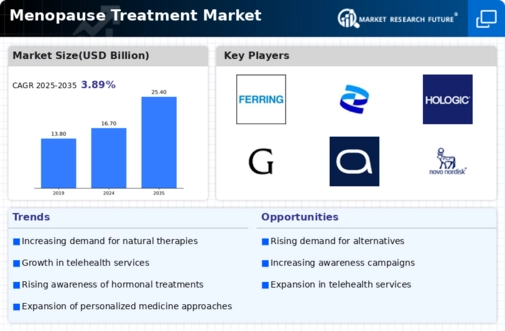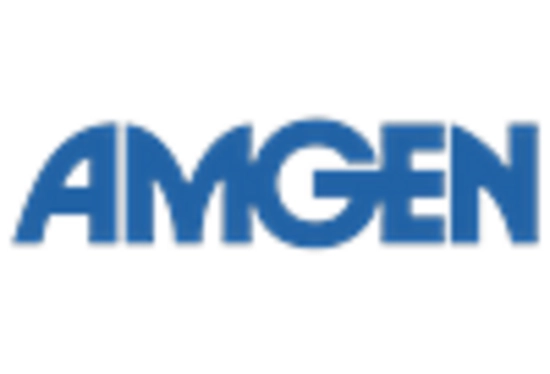Hormone Replacement Therapy
Non-Hormonal Therapy
Lifestyle Changes
Alternative Therapies
Oral
Transdermal
Injectable
Vaginal
Hospitals
Gynecology Clinics
Homecare Settings
Pharmacies
Estrogens
Progestogens
Selective Estrogen Receptor Modulators
Antidepressants
North America
Europe
South America
Asia Pacific
Middle East and Africa
North America Outlook (USD Billion, 2019-2035)
North America Menopause Treatment Market by Treatment Type
Hormone Replacement Therapy
Non-Hormonal Therapy
Lifestyle Changes
Alternative Therapies
North America Menopause Treatment Market by Route of Administration Type
Oral
Transdermal
Injectable
Vaginal
North America Menopause Treatment Market by End User Type
Hospitals
Gynecology Clinics
Homecare Settings
Pharmacies
North America Menopause Treatment Market by Drug Class Type
Estrogens
Progestogens
Selective Estrogen Receptor Modulators
Antidepressants
North America Menopause Treatment Market by Regional Type
US
Canada
US Outlook (USD Billion, 2019-2035)
US Menopause Treatment Market by Treatment Type
Hormone Replacement Therapy
Non-Hormonal Therapy
Lifestyle Changes
Alternative Therapies
US Menopause Treatment Market by Route of Administration Type
Oral
Transdermal
Injectable
Vaginal
US Menopause Treatment Market by End User Type
Hospitals
Gynecology Clinics
Homecare Settings
Pharmacies
US Menopause Treatment Market by Drug Class Type
Estrogens
Progestogens
Selective Estrogen Receptor Modulators
Antidepressants
CANADA Outlook (USD Billion, 2019-2035)
CANADA Menopause Treatment Market by Treatment Type
Hormone Replacement Therapy
Non-Hormonal Therapy
Lifestyle Changes
Alternative Therapies
CANADA Menopause Treatment Market by Route of Administration Type
Oral
Transdermal
Injectable
Vaginal
CANADA Menopause Treatment Market by End User Type
Hospitals
Gynecology Clinics
Homecare Settings
Pharmacies
CANADA Menopause Treatment Market by Drug Class Type
Estrogens
Progestogens
Selective Estrogen Receptor Modulators
Antidepressants
Europe Outlook (USD Billion, 2019-2035)
Europe Menopause Treatment Market by Treatment Type
Hormone Replacement Therapy
Non-Hormonal Therapy
Lifestyle Changes
Alternative Therapies
Europe Menopause Treatment Market by Route of Administration Type
Oral
Transdermal
Injectable
Vaginal
Europe Menopause Treatment Market by End User Type
Hospitals
Gynecology Clinics
Homecare Settings
Pharmacies
Europe Menopause Treatment Market by Drug Class Type
Estrogens
Progestogens
Selective Estrogen Receptor Modulators
Antidepressants
Europe Menopause Treatment Market by Regional Type
Germany
UK
France
Russia
Italy
Spain
Rest of Europe
GERMANY Outlook (USD Billion, 2019-2035)
GERMANY Menopause Treatment Market by Treatment Type
Hormone Replacement Therapy
Non-Hormonal Therapy
Lifestyle Changes
Alternative Therapies
GERMANY Menopause Treatment Market by Route of Administration Type
Oral
Transdermal
Injectable
Vaginal
GERMANY Menopause Treatment Market by End User Type
Hospitals
Gynecology Clinics
Homecare Settings
Pharmacies
GERMANY Menopause Treatment Market by Drug Class Type
Estrogens
Progestogens
Selective Estrogen Receptor Modulators
Antidepressants
UK Outlook (USD Billion, 2019-2035)
UK Menopause Treatment Market by Treatment Type
Hormone Replacement Therapy
Non-Hormonal Therapy
Lifestyle Changes
Alternative Therapies
UK Menopause Treatment Market by Route of Administration Type
Oral
Transdermal
Injectable
Vaginal
UK Menopause Treatment Market by End User Type
Hospitals
Gynecology Clinics
Homecare Settings
Pharmacies
UK Menopause Treatment Market by Drug Class Type
Estrogens
Progestogens
Selective Estrogen Receptor Modulators
Antidepressants
FRANCE Outlook (USD Billion, 2019-2035)
FRANCE Menopause Treatment Market by Treatment Type
Hormone Replacement Therapy
Non-Hormonal Therapy
Lifestyle Changes
Alternative Therapies
FRANCE Menopause Treatment Market by Route of Administration Type
Oral
Transdermal
Injectable
Vaginal
FRANCE Menopause Treatment Market by End User Type
Hospitals
Gynecology Clinics
Homecare Settings
Pharmacies
FRANCE Menopause Treatment Market by Drug Class Type
Estrogens
Progestogens
Selective Estrogen Receptor Modulators
Antidepressants
RUSSIA Outlook (USD Billion, 2019-2035)
RUSSIA Menopause Treatment Market by Treatment Type
Hormone Replacement Therapy
Non-Hormonal Therapy
Lifestyle Changes
Alternative Therapies
RUSSIA Menopause Treatment Market by Route of Administration Type
Oral
Transdermal
Injectable
Vaginal
RUSSIA Menopause Treatment Market by End User Type
Hospitals
Gynecology Clinics
Homecare Settings
Pharmacies
RUSSIA Menopause Treatment Market by Drug Class Type
Estrogens
Progestogens
Selective Estrogen Receptor Modulators
Antidepressants
ITALY Outlook (USD Billion, 2019-2035)
ITALY Menopause Treatment Market by Treatment Type
Hormone Replacement Therapy
Non-Hormonal Therapy
Lifestyle Changes
Alternative Therapies
ITALY Menopause Treatment Market by Route of Administration Type
Oral
Transdermal
Injectable
Vaginal
ITALY Menopause Treatment Market by End User Type
Hospitals
Gynecology Clinics
Homecare Settings
Pharmacies
ITALY Menopause Treatment Market by Drug Class Type
Estrogens
Progestogens
Selective Estrogen Receptor Modulators
Antidepressants
SPAIN Outlook (USD Billion, 2019-2035)
SPAIN Menopause Treatment Market by Treatment Type
Hormone Replacement Therapy
Non-Hormonal Therapy
Lifestyle Changes
Alternative Therapies
SPAIN Menopause Treatment Market by Route of Administration Type
Oral
Transdermal
Injectable
Vaginal
SPAIN Menopause Treatment Market by End User Type
Hospitals
Gynecology Clinics
Homecare Settings
Pharmacies
SPAIN Menopause Treatment Market by Drug Class Type
Estrogens
Progestogens
Selective Estrogen Receptor Modulators
Antidepressants
REST OF EUROPE Outlook (USD Billion, 2019-2035)
REST OF EUROPE Menopause Treatment Market by Treatment Type
Hormone Replacement Therapy
Non-Hormonal Therapy
Lifestyle Changes
Alternative Therapies
REST OF EUROPE Menopause Treatment Market by Route of Administration Type
Oral
Transdermal
Injectable
Vaginal
REST OF EUROPE Menopause Treatment Market by End User Type
Hospitals
Gynecology Clinics
Homecare Settings
Pharmacies
REST OF EUROPE Menopause Treatment Market by Drug Class Type
Estrogens
Progestogens
Selective Estrogen Receptor Modulators
Antidepressants
APAC Outlook (USD Billion, 2019-2035)
APAC Menopause Treatment Market by Treatment Type
Hormone Replacement Therapy
Non-Hormonal Therapy
Lifestyle Changes
Alternative Therapies
APAC Menopause Treatment Market by Route of Administration Type
Oral
Transdermal
Injectable
Vaginal
APAC Menopause Treatment Market by End User Type
Hospitals
Gynecology Clinics
Homecare Settings
Pharmacies
APAC Menopause Treatment Market by Drug Class Type
Estrogens
Progestogens
Selective Estrogen Receptor Modulators
Antidepressants
APAC Menopause Treatment Market by Regional Type
China
India
Japan
South Korea
Malaysia
Thailand
Indonesia
Rest of APAC
CHINA Outlook (USD Billion, 2019-2035)
CHINA Menopause Treatment Market by Treatment Type
Hormone Replacement Therapy
Non-Hormonal Therapy
Lifestyle Changes
Alternative Therapies
CHINA Menopause Treatment Market by Route of Administration Type
Oral
Transdermal
Injectable
Vaginal
CHINA Menopause Treatment Market by End User Type
Hospitals
Gynecology Clinics
Homecare Settings
Pharmacies
CHINA Menopause Treatment Market by Drug Class Type
Estrogens
Progestogens
Selective Estrogen Receptor Modulators
Antidepressants
INDIA Outlook (USD Billion, 2019-2035)
INDIA Menopause Treatment Market by Treatment Type
Hormone Replacement Therapy
Non-Hormonal Therapy
Lifestyle Changes
Alternative Therapies
INDIA Menopause Treatment Market by Route of Administration Type
Oral
Transdermal
Injectable
Vaginal
INDIA Menopause Treatment Market by End User Type
Hospitals
Gynecology Clinics
Homecare Settings
Pharmacies
INDIA Menopause Treatment Market by Drug Class Type
Estrogens
Progestogens
Selective Estrogen Receptor Modulators
Antidepressants
JAPAN Outlook (USD Billion, 2019-2035)
JAPAN Menopause Treatment Market by Treatment Type
Hormone Replacement Therapy
Non-Hormonal Therapy
Lifestyle Changes
Alternative Therapies
JAPAN Menopause Treatment Market by Route of Administration Type
Oral
Transdermal
Injectable
Vaginal
JAPAN Menopause Treatment Market by End User Type
Hospitals
Gynecology Clinics
Homecare Settings
Pharmacies
JAPAN Menopause Treatment Market by Drug Class Type
Estrogens
Progestogens
Selective Estrogen Receptor Modulators
Antidepressants
SOUTH KOREA Outlook (USD Billion, 2019-2035)
SOUTH KOREA Menopause Treatment Market by Treatment Type
Hormone Replacement Therapy
Non-Hormonal Therapy
Lifestyle Changes
Alternative Therapies
SOUTH KOREA Menopause Treatment Market by Route of Administration Type
Oral
Transdermal
Injectable
Vaginal
SOUTH KOREA Menopause Treatment Market by End User Type
Hospitals
Gynecology Clinics
Homecare Settings
Pharmacies
SOUTH KOREA Menopause Treatment Market by Drug Class Type
Estrogens
Progestogens
Selective Estrogen Receptor Modulators
Antidepressants
MALAYSIA Outlook (USD Billion, 2019-2035)
MALAYSIA Menopause Treatment Market by Treatment Type
Hormone Replacement Therapy
Non-Hormonal Therapy
Lifestyle Changes
Alternative Therapies
MALAYSIA Menopause Treatment Market by Route of Administration Type
Oral
Transdermal
Injectable
Vaginal
MALAYSIA Menopause Treatment Market by End User Type
Hospitals
Gynecology Clinics
Homecare Settings
Pharmacies
MALAYSIA Menopause Treatment Market by Drug Class Type
Estrogens
Progestogens
Selective Estrogen Receptor Modulators
Antidepressants
THAILAND Outlook (USD Billion, 2019-2035)
THAILAND Menopause Treatment Market by Treatment Type
Hormone Replacement Therapy
Non-Hormonal Therapy
Lifestyle Changes
Alternative Therapies
THAILAND Menopause Treatment Market by Route of Administration Type
Oral
Transdermal
Injectable
Vaginal
THAILAND Menopause Treatment Market by End User Type
Hospitals
Gynecology Clinics
Homecare Settings
Pharmacies
THAILAND Menopause Treatment Market by Drug Class Type
Estrogens
Progestogens
Selective Estrogen Receptor Modulators
Antidepressants
INDONESIA Outlook (USD Billion, 2019-2035)
INDONESIA Menopause Treatment Market by Treatment Type
Hormone Replacement Therapy
Non-Hormonal Therapy
Lifestyle Changes
Alternative Therapies
INDONESIA Menopause Treatment Market by Route of Administration Type
Oral
Transdermal
Injectable
Vaginal
INDONESIA Menopause Treatment Market by End User Type
Hospitals
Gynecology Clinics
Homecare Settings
Pharmacies
INDONESIA Menopause Treatment Market by Drug Class Type
Estrogens
Progestogens
Selective Estrogen Receptor Modulators
Antidepressants
REST OF APAC Outlook (USD Billion, 2019-2035)
REST OF APAC Menopause Treatment Market by Treatment Type
Hormone Replacement Therapy
Non-Hormonal Therapy
Lifestyle Changes
Alternative Therapies
REST OF APAC Menopause Treatment Market by Route of Administration Type
Oral
Transdermal
Injectable
Vaginal
REST OF APAC Menopause Treatment Market by End User Type
Hospitals
Gynecology Clinics
Homecare Settings
Pharmacies
REST OF APAC Menopause Treatment Market by Drug Class Type
Estrogens
Progestogens
Selective Estrogen Receptor Modulators
Antidepressants
South America Outlook (USD Billion, 2019-2035)
South America Menopause Treatment Market by Treatment Type
Hormone Replacement Therapy
Non-Hormonal Therapy
Lifestyle Changes
Alternative Therapies
South America Menopause Treatment Market by Route of Administration Type
Oral
Transdermal
Injectable
Vaginal
South America Menopause Treatment Market by End User Type
Hospitals
Gynecology Clinics
Homecare Settings
Pharmacies
South America Menopause Treatment Market by Drug Class Type
Estrogens
Progestogens
Selective Estrogen Receptor Modulators
Antidepressants
South America Menopause Treatment Market by Regional Type
Brazil
Mexico
Argentina
Rest of South America
BRAZIL Outlook (USD Billion, 2019-2035)
BRAZIL Menopause Treatment Market by Treatment Type
Hormone Replacement Therapy
Non-Hormonal Therapy
Lifestyle Changes
Alternative Therapies
BRAZIL Menopause Treatment Market by Route of Administration Type
Oral
Transdermal
Injectable
Vaginal
BRAZIL Menopause Treatment Market by End User Type
Hospitals
Gynecology Clinics
Homecare Settings
Pharmacies
BRAZIL Menopause Treatment Market by Drug Class Type
Estrogens
Progestogens
Selective Estrogen Receptor Modulators
Antidepressants
MEXICO Outlook (USD Billion, 2019-2035)
MEXICO Menopause Treatment Market by Treatment Type
Hormone Replacement Therapy
Non-Hormonal Therapy
Lifestyle Changes
Alternative Therapies
MEXICO Menopause Treatment Market by Route of Administration Type
Oral
Transdermal
Injectable
Vaginal
MEXICO Menopause Treatment Market by End User Type
Hospitals
Gynecology Clinics
Homecare Settings
Pharmacies
MEXICO Menopause Treatment Market by Drug Class Type
Estrogens
Progestogens
Selective Estrogen Receptor Modulators
Antidepressants
ARGENTINA Outlook (USD Billion, 2019-2035)
ARGENTINA Menopause Treatment Market by Treatment Type
Hormone Replacement Therapy
Non-Hormonal Therapy
Lifestyle Changes
Alternative Therapies
ARGENTINA Menopause Treatment Market by Route of Administration Type
Oral
Transdermal
Injectable
Vaginal
ARGENTINA Menopause Treatment Market by End User Type
Hospitals
Gynecology Clinics
Homecare Settings
Pharmacies
ARGENTINA Menopause Treatment Market by Drug Class Type
Estrogens
Progestogens
Selective Estrogen Receptor Modulators
Antidepressants
REST OF SOUTH AMERICA Outlook (USD Billion, 2019-2035)
REST OF SOUTH AMERICA Menopause Treatment Market by Treatment Type
Hormone Replacement Therapy
Non-Hormonal Therapy
Lifestyle Changes
Alternative Therapies
REST OF SOUTH AMERICA Menopause Treatment Market by Route of Administration Type
Oral
Transdermal
Injectable
Vaginal
REST OF SOUTH AMERICA Menopause Treatment Market by End User Type
Hospitals
Gynecology Clinics
Homecare Settings
Pharmacies
REST OF SOUTH AMERICA Menopause Treatment Market by Drug Class Type
Estrogens
Progestogens
Selective Estrogen Receptor Modulators
Antidepressants
MEA Outlook (USD Billion, 2019-2035)
MEA Menopause Treatment Market by Treatment Type
Hormone Replacement Therapy
Non-Hormonal Therapy
Lifestyle Changes
Alternative Therapies
MEA Menopause Treatment Market by Route of Administration Type
Oral
Transdermal
Injectable
Vaginal
MEA Menopause Treatment Market by End User Type
Hospitals
Gynecology Clinics
Homecare Settings
Pharmacies
MEA Menopause Treatment Market by Drug Class Type
Estrogens
Progestogens
Selective Estrogen Receptor Modulators
Antidepressants
MEA Menopause Treatment Market by Regional Type
GCC Countries
South Africa
Rest of MEA
GCC COUNTRIES Outlook (USD Billion, 2019-2035)
GCC COUNTRIES Menopause Treatment Market by Treatment Type
Hormone Replacement Therapy
Non-Hormonal Therapy
Lifestyle Changes
Alternative Therapies
GCC COUNTRIES Menopause Treatment Market by Route of Administration Type
Oral
Transdermal
Injectable
Vaginal
GCC COUNTRIES Menopause Treatment Market by End User Type
Hospitals
Gynecology Clinics
Homecare Settings
Pharmacies
GCC COUNTRIES Menopause Treatment Market by Drug Class Type
Estrogens
Progestogens
Selective Estrogen Receptor Modulators
Antidepressants
SOUTH AFRICA Outlook (USD Billion, 2019-2035)
SOUTH AFRICA Menopause Treatment Market by Treatment Type
Hormone Replacement Therapy
Non-Hormonal Therapy
Lifestyle Changes
Alternative Therapies
SOUTH AFRICA Menopause Treatment Market by Route of Administration Type
Oral
Transdermal
Injectable
Vaginal
SOUTH AFRICA Menopause Treatment Market by End User Type
Hospitals
Gynecology Clinics
Homecare Settings
Pharmacies
SOUTH AFRICA Menopause Treatment Market by Drug Class Type
Estrogens
Progestogens
Selective Estrogen Receptor Modulators
Antidepressants
REST OF MEA Outlook (USD Billion, 2019-2035)
REST OF MEA Menopause Treatment Market by Treatment Type
Hormone Replacement Therapy
Non-Hormonal Therapy
Lifestyle Changes
Alternative Therapies
REST OF MEA Menopause Treatment Market by Route of Administration Type
Oral
Transdermal
Injectable
Vaginal
REST OF MEA Menopause Treatment Market by End User Type
Hospitals
Gynecology Clinics
Homecare Settings
Pharmacies
REST OF MEA Menopause Treatment Market by Drug Class Type
Estrogens
Progestogens
Selective Estrogen Receptor Modulators
Antidepressants

















Leave a Comment